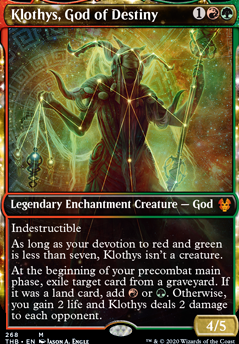Creature (32)
- 1x Apex Altisaur
- 1x Beast Whisperer
- 1x Birds of Paradise
- 1x Bloom Tender
- 1x Bramble Sovereign
- 1x Burning-Tree Shaman
- 1x Chandra's Incinerator
- 1x Collector Ouphe
-
1x
Courser of Kruphix

- 1x Dosan the Falling Leaf
- 1x Dragon Mage
- 1x Elvish Mystic
- 1x Eternal Witness
-
1x
Fiendish Duo

- 1x Harsh Mentor
- 1x Heartless Hidetsugu
- 1x Immolation Shaman
- 1x Imperial Recruiter
- 1x Magus of the Moon
- 1x Magus of the Wheel
- 1x Manglehorn
- 1x Neheb, the Eternal
- 1x Ruric Thar, the Unbowed
- 1x Sakura-Tribe Elder
- 1x Scavenging Ooze
- 1x Springbloom Druid
- 1x Toralf, God of Fury Flip
- 1x Torbran, Thane of Red Fell
- 1x Vizier of the Menagerie
- 1x Wandering Archaic Flip
- 1x Zhur-Taa Druid
- 1x Zo-Zu the Punisher
Enchantment (15)
- 1x Cindervines
- 1x Dictate of the Twin Gods
- 1x Fiery Emancipation
- 1x Furnace of Rath
- 1x Hall of Gemstone
- 1x Kenrith's Transformation
- 1x Manabarbs
- 1x Price of Glory
- 1x Primal Order
- 1x Rhythm of the Wild
- 1x Roiling Vortex
- 1x Snake Umbra
- 1x Song of the Dryads
- 1x Spellshock
- 1x Sylvan Library
Instant (8)
- 1x Beast Within
- 1x Chaos Warp
- 1x Force of Vigor
- 1x Heroic Intervention
- 1x Impact Resonance
- 1x Price of Progress
- 1x Road / Ruin
- 1x Worldly Tutor
Artifact (4)
Commander (1)
Land (33)
- 1x Fabled Passage
- 12x Forest
- 1x Homeward Path
- 1x Kessig Wolf Run
- 12x Mountain
- 1x Nykthos, Shrine to Nyx
- 1x Prismatic Vista
- 1x Scavenger Grounds
- 1x Shivan Gorge
- 1x Witch's Clinic
-
1x
Wooded Foothills

Sorcery (7)
Suggestions
Updates Add
Comments
Attention! Complete Comment Tutorial! This annoying message will go away once you do!
Important! Formatting tips — Comment Tutorial — markdown syntax
Please login to comment
96% Casual
Competitive
| Date added | 4 years |
| Last updated | 2 years |
| Legality | This deck is Commander / EDH legal. |
| Rarity (main - side) | 10 - 0 Mythic Rares 50 - 0 Rares 12 - 0 Uncommons 4 - 0 Commons |
| Cards | 100 |
| Avg. CMC | 3.40 |
| Tokens | Beast 3/3 G, Copy Clone |
| Votes | |
| Ignored suggestions | |
| Shared with | |
| Views |

